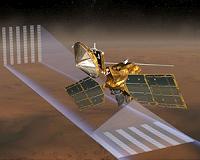 |
Denver CO (SPX) Oct 06, 2010 NASA's Mars Atmosphere and Volatile Evolution (MAVEN) project passed its Mission Confirmation Review on Oct. 4. As a result, NASA has given approval for the development and 2013 launch of the MAVEN mission. Lockheed Martin [NYSE: LMT] is the industry partner for the mission and will design and build the spacecraft and perform flight operations. This major milestone was the culmination of a process involving NASA executives and industry experts that thoroughly reviewed the mission, science and spacecraft plans to ensure MAVEN can be developed on schedule, within budget, with acceptable risk, and will result in a reliable spacecraft that will accomplish all of NASA's objectives for the project. Images of the Martian surface indicate that there was once liquid water present, which would have required a warmer and thicker atmosphere sometime in the past. Carrying three science instrument suites, the MAVEN spacecraft will probe the upper atmosphere of Mars and its interactions with the sun to learn how the Martian atmosphere behaves in the context of solar activity. With this information, scientists will be able to recreate the history of Mars' atmosphere - what it was once like and what happened to it. The principal investigator for the MAVEN mission is Dr. Bruce Jakosky of the Laboratory for Atmospheric and Space Physics (LASP) at the University of Colorado (CU) at Boulder. "The MAVEN spacecraft team is ready and eager to move forward with the detailed design of the spacecraft and ultimately to the successful launch and operations of this important mission," said Guy Beutelschies, MAVEN program manager at Lockheed Martin Space Systems Company. Launch of the MAVEN spacecraft is scheduled for November 2013, and arrival and orbit insertion around Mars is scheduled for September 2014. MAVEN is the second mission in the Mars Scout Program which is designed to send small, low-cost, principal investigator-led missions to the Red Planet. The Phoenix Mars Lander was the first Mars Scout mission and was also built and flown by Lockheed Martin for NASA. Regarding passing the MAVEN Mission Confirmation Review, Dr. Jakosky said, "A better understanding of the upper atmosphere and the role that escape to space has played is required to plug a major hole in our understanding of Mars. We're really excited about having the opportunity to address these fundamental science questions." "The team has successfully met every major milestone since selection two years ago," said MAVEN Project Manager David Mitchell of NASA's Goddard Space Flight Center, Greenbelt, Md. "Looking forward, we are well positioned for the next push to critical design review in July 2011. In three short years, we'll be heading to Mars!" NASA Goddard will manage the project and will also build some of the instruments for the mission. In addition to the principal investigator coming from CU-LASP, the university will provide science operations, build instruments, and lead education/public outreach. Lockheed Martin of Littleton, Colo., will build the spacecraft based on designs from NASA's Mars Reconnaissance Orbiter and 2001 Mars Odyssey missions and perform mission operations. The University of California-Berkeley Space Sciences Laboratory will also build instruments for the mission. NASA's Jet Propulsion Laboratory, Pasadena, Calif., will provide navigation support, the Deep Space Network, and the Electra telecommunications relay hardware and operations.
Share This Article With Planet Earth
Related Links Mars at JPL Mars News and Information at MarsDaily.com Lunar Dreams and more
 Atmosphere Checked, One Mars Year Before A Landing
Atmosphere Checked, One Mars Year Before A LandingPasadena CA (JPL) Sep 30, 2010 What will the Martian atmosphere be like when the next Mars rover descends through it for landing in August of 2012? An instrument studying the Martian atmosphere from orbit has begun a four-week campaign to characterize daily atmosphere changes, one Mars year before the arrival of the Mars Science Laboratory rover, Curiosity. A Mars year equals 687 Earth days. The planet's thin atmosphere ... read more |
|
| The content herein, unless otherwise known to be public domain, are Copyright 1995-2010 - SpaceDaily. AFP and UPI Wire Stories are copyright Agence France-Presse and United Press International. ESA Portal Reports are copyright European Space Agency. All NASA sourced material is public domain. Additional copyrights may apply in whole or part to other bona fide parties. Advertising does not imply endorsement,agreement or approval of any opinions, statements or information provided by SpaceDaily on any Web page published or hosted by SpaceDaily. Privacy Statement |